CEDARWOOD
OILS
Part
1
Copyright
Tony Burfield Sept. 2002
[This
article first appeared in Aromatherapy Times, Vol 1 No.55 pp14-15 Winter
2002, and is reproduced by kind permission of the editor].
Short Cut to Part 2
Short Cut to Part 3
§
1. BOTANICAL NAMES
True
cedars
come from four closely related Cedrus species
·
Atlas
Cedar Cedrus. atlantica (Endl.)Manetti
ex Carr
·
Cyprian
Cedar Cedrus brevifolia Henry
·
Himalayan
Cedar Cedrus deodara (D. Don) G.
Don. f. (“Deodar”)
·
Lebanese
Cedar Cedrus. libani A. Rich.
Commercial
“Cedarwood oils” are obtained from 3 main genera of Cupressaceae:
·
Juniperus
spp. for Texas and Virginian Cedarwood oils)
·
Cedrus
(for Moroccan and Indian oils)
·
Cupressus
(for
Chinese oils).
In
1985 Lawrence reviewed the world production and found the following annual
production figures:
Texas Juniperus ashei Buchh.
1400
tons
Virginia
Juniperus virginiana L.
240
tons
China
Juniperus funebris Endl.
450
tons
India Cedrus deodara 20 tons
Morocco
Cedrus atlantica
7
tons
Kenya
Juniperus procera Endl.
– no production.
Many
other Cedarwoods are known, and distilled on a minor scale for oil:
·
Mulanje
cedarwood Widdrington whytei Rendle syn. W.
nodiflora (L.) Powrie
·
Port
Oxford or Oregon Cedarwood Chamaecyparis
lawsoniana
·
Weeping
Blue Juniper Juniperus recurva Buch.-Ham.
·
Hibawood
oil Thujopsis dolabrata (L.f.) Siebold
& Zucc.
Hibawood
oil was formerly used as a perfumery ingredient.
§2.
STATUS OF CEDARWOOD ATLAS AND CEDARWOOD HIMALAYAN
(a)
Cedarwood oil Atlas
is produced by steam distillation of the waste wood, or sawdust of the tree,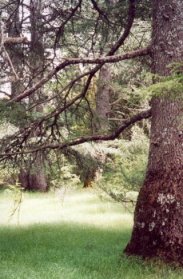 which can grow to 65m. at an elevation of 1400-2500m. in on several types
of soil in 133,653 hectares of Cedar forest (Mardaga 1999) in the Moroccan
Middle Atlas, Rif central and Grand Atlas Oriental and Middle Atlas oriental. It
has been estimated that Cedar forest might which constitute 2.8% of the total
area of Moroccan forest. The tree also grows in NW Algeria, and has been
imported into N. America & Canada. The tree has been important in the
socio-economy of Morocco, being good for furniture making. Whilst Cedarwood
atlas trees are well conserved in specific area of parkland, the ecosystem is
very fragile - often the margins are subject to degradation by erosion,
demineralisation, dehydration, desertification etc. resulting in areas of
complete desolation. From what I have seen there this year, the Moroccan
ministry of Agriculture and various other bodies are doing all they can in very
difficult circumstances to conserve the rich biodiversity of plants in Morocco.
which can grow to 65m. at an elevation of 1400-2500m. in on several types
of soil in 133,653 hectares of Cedar forest (Mardaga 1999) in the Moroccan
Middle Atlas, Rif central and Grand Atlas Oriental and Middle Atlas oriental. It
has been estimated that Cedar forest might which constitute 2.8% of the total
area of Moroccan forest. The tree also grows in NW Algeria, and has been
imported into N. America & Canada. The tree has been important in the
socio-economy of Morocco, being good for furniture making. Whilst Cedarwood
atlas trees are well conserved in specific area of parkland, the ecosystem is
very fragile - often the margins are subject to degradation by erosion,
demineralisation, dehydration, desertification etc. resulting in areas of
complete desolation. From what I have seen there this year, the Moroccan
ministry of Agriculture and various other bodies are doing all they can in very
difficult circumstances to conserve the rich biodiversity of plants in Morocco.
(b) Cedarwood Himalayan
Cedarwood oil
Himalayan which can reach 50m. is produced by steam distillation of the
fragrant wood, saw dust, shavings and stumps of the tall evergreen tree which
grows on the Himalayan slopes of N. India, Afghanistan and Pakistan, at
elevations between 1650-2400m.
As early as 1958, Chowdhury KA and Gosh S noted that the three most plentiful
timbers in India were Tectona grandis, Shorea robusta and Cedrus
deodara. Cedrus deodara
is been extensively used for external structures (not for internal work; it is
too knotty and will not take paint), and is the wood of choice for railway
sleepers. Its very usefulness has lead to its over-exploitation. The oil has
plummeted in production volume from 20 tons/annum in the 1970’s, to about a
ton presently.
§3.
CHEMISTRY AND ODOUR.
1.
Cedrus atlantica
Odour:
It is a yellow-brown to brown oil with dirty-woody, resinous, urinous odour.
The dry-down on a perfumers strip is still woody-dirty, and takes on
an almost Plasticine impression. It is very persistent.
Chemistry:
Essential oil is mainly composed of sesquiterpene hydrocarbons a-himalchene,
b-himalchene,
and g-himalchene
which together can make up almost 70% of the composition
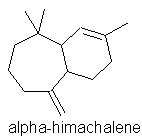
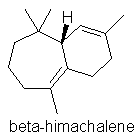
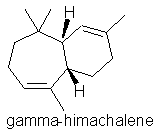
The
oil also contains a number of a-
and g-atlantone
isomers, especially (E)-(+)-a-atlantone,
which can constitute 10-15% in total of the oil (a-
& g-atlantone
are sweet smelling woody odourants and especially contribute towards the odour
of the oil).
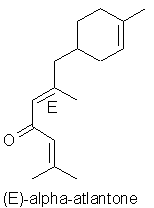
Analysis
(TB unreleased data):
a-pinene
tr., g-himachalene
10.87%, b-himachalene
54.00%, a-himachalene
17.22%, d-cadinene
1.48%, a-humulene,
0.54%, b-calcorene,
0.74%, cedrene epoxide (??) 0.45%, b-himachalene
oxide 0.34%, a-cedrene
0.49%, E- a-atlantone
1.41%, g-atlantone
1.69%.
The
oil is widely used for insect repellent activities; Turkish carpet shops
are walled with cedarwood boards to deter moths. Cedarwood oil Atlas is used in
local ethnobotanical medicine for a wide variety of purposes.
2.
Cedrus
deodara.
Odour:
The oil is yellow-brown to reddish brown, slightly viscous oil with an odour that is slightly dirty, somewhat crude and woody, and also
sweet resinous. It is lighter than Cedarwood oil Atlas, somewhat urinic, with a
limonene/citrus aspect. There is also sometimes a hint of a cassis-like note.
The dry-down is dirty woody with
an almost cresylic character - almost narcissus-like
Chemistry:
Older literature suggests that the characteristic odour of C. deodora is due
to the presence of p-methyl-d-3-
tetrahydroacetophenone, but the oil also contains p-methyl acetophenone, cis-
and trans- atlantones, a-
and b-himalchenes,
ar-dihydroturmerone as well as (+)-himachalol and (+)-allohimachalol, amongst
others. The oil sold to aromatheraists is usually rectified – the unrectified
oil is dirtier and more crudely resinous and urinic, also possessing a slight
cassis note.
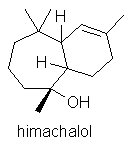
The
oil itself finds use in Ayurvedic medicine, as an anti-helmintic; decoctions of
the wood being considered diaphoretic, diuretic and carminative. The bark is
astringent and used for fevers, diarrhea and dysentry
and the oleoresin and oil of the wood are used for treatment of ulcers and skin
diseases.
§4.
OTHER CEDARWOOD OILS
(a)
Cedarwood oil Chinese Cupressus funebris (Endl.)
Franco
Produced by steam distillation of
the wood of Chinese Weeping Cypress, which is an evergreen shrub growing in
Kweichow and Shaansi, Guizhou, Kansu, and Szechwan provinces. The oil and wood
are also used to prepare incense in China. Annual output in China was given as
1000-1500 tons Zhaobang (1995). Burfield (2002) gives the analysis as:
a
-cedrene 27.1%, b-cedrene
8.8%, thujopsene 30.0%, a-himalchene
0.5%,b-himalchene
0.5%, ar-curcmene 0.4%, a-selinene
3.0%, cuparene 3.3%,cedrol 12.0%, widdrol 4.9%, methyl carvacrol 0.6%
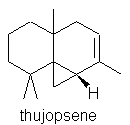
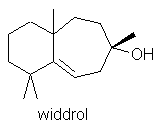
The
oil from C. funebris is pale yellow or yellow-green, with an odour
that is almost invariably smoky, woody, bordering on crude, with an almost
cresylic character. In comparison cedarwood oil Virginian appears smooth woody, slightly oily pencil
sharpenings, and somewhat slightly sweet in comparison. The Chinese oil is,
however, more powerful.
The USA and Europe import large quantities of the Chinese oil - as it is
a quarter of the price of Texan and Virginian Cedarwood oils, it is widely used
as an adulterant of these oils.
(b) Cedarwood oil Texas Juniperus
ashei Buchholz
Texas/Mexican
cedarwood oil essential oil is produced by steam distillation of the wood or
wood shavings of the small tree, which grows in Texas, Mexico and parts of
Central America. Cedarwood oil sold for under $4 per kilo in the nineties – it
has always been cheap so there was little profit in harvesting Cedarwood trees,
and millions of acres of farmland became invaded by this opportunist species.
The US government offered incentives to clear this land, so that wood to produce
the oil is in adequate supply. New technology (continual distillation termed
“steam stripping” used by Texarome Inc. of Texas) replaces the older steam
distillation process, which used to take up the 8 hours to remove the essential
oil. G. R. Boucard and R.W. Serth “Practical Design of a continuous
distillation plant for the separation of aromatic raw materials” can be viewed
on http://207.71.36.16/distil.htm.
The
odour profile of the oil is of
intense pencil sharpenings, smoky, woody notes with aspects of guaiacwood, but
much drier than other Cedarwood oils. Dry-down is woody, smoky, and dry.
Cedarwood oil Texas contains a-cedrene,
b-cedrene,
thujopsene, widdrol, pseudo-cedrol, b-chamigrene,
cedrol, widdrene, isowiddrene, a-chamigrene
and three cuparene isomers.
©
Phoenician Juniper Juniperus
phoenicea. L.
Distilled
from wood of shrub, or small conical tree
distributed throughout Mediterranean, and N. Africa and Canary Islands and which
grows to 17m. Entire forests of J.
phoenicea, growing to 2000 m. can be found in Algeria. In Morocco J.
phoenicea f. megalocarpa Maire
in also found on the E. coastal parts of Morocco. J.
phoenicea var. turbinata Parlatore
with egg-shaped seeds has also been described as growing in Algeria, Spain,
Italy and Sicily.
The
odour of the Lebanese oil is
pine-like with
some turpentine elements, almost cineolic; very toppy; oily; underneath some
leathery warm labdanum character. Dry-down
is powerful amber, labdanum-like, resinous. It has been noted by the author
the the amber note intensity is seasonal.
B.M.
Lawrence reports on the terpene hydrocarbon composition of J.
phoenicea giving the main component as a-pinene
as 70.4% followed by limonene and b-phellandrene
at 8.3% ref Perf & Flav Dec
1987/Jan 1988 p60. R.P.Adams et al
(1991) compared the leaf oils of J.
phoenicea, J phoenicea subsp. eu-meditrerranea and J.
phoenicea var. turbinata (Guss.)
Parl. They discovered that all oils were a-pinene
dominant but J. phoenicea contained
moderate amounts of myrcene, limonene, b-phellandrene,
a-terpinyl
acetate and 1-epi-cubenol.
(d)
Droopping Juniper Juniperus
recurva Buch-ham
ex D. Don.
Small tree of conical
habit, with stringy shaggy bark and drooping branches. Of interest as the wood
and sawdust of this spp. and especially var coxii
is burnt as incense, and set out in open vessels scenting the air with a cedarwood-like
fragrance in Buddhist temples in the E. Himalaya.
(e)
Cedarwood
oil Virginian
Juniperus
virginiana
L.
Virginian
cedarwood oil is the volatile essential oil produced by the steam distillation
of the chopped wood, stumps, logs, wood shavings or sawdust of the slow-growing
Eastern Red Cedar, growing in the S.E. of USA, Canada and Japan. The oil
is yellow to yellow-brown (sometimes red-brown), often solid or semi-solid at
room temperature due to precipitated cedrol. Redistilled oils, where sold, are
almost colourless. The oil has a woody, oily, somewhat dry odour
but cleaner, and markedly smoother than Atlas or Himalayan oils although less
powerful. There is a distinct pencil-sharpenings note. Dry-down is still smooth woody-oily, retaining the pencil-sharpenings
aspect.
Virginia
cedarwood is considered by many perfumers to have a smoother and finer (but less
powerful) odour than Texas oil. The major odour impact compound of cedarwood
oils is considered to be (+)-a-cedrol,
which occurs at up to 15% in the oil; the major portion of the oil being
composed a-
and b-cedrenes
and thujopsene which are weak woody odourants. The sesquiterpene hydrocarbon
content is 55 and 65%. Cedarwood
oil Virginia shows a higher cedrol content than the Texas oil, and higher b-caryophyllene
and g-eudesmol,
whereas Chinese oils show higher thujopsene contents.
Cedarwood oil Virginia is additionally used in insecticides, polishes and
cleaning products, soaps, liniments, and cedarwood still-residues have been used
in the manufacture of linoleum.
§5.
COMMENTS.
Although
there are some similarities in the major chemical constituents of Cedrus
atlantica and Cedrus deodara, there is little similarity between the
latter oils and Cupressus
funebris, Juniperus ashei or
Juniperus
virginiana etc.
Any
therapeutic
properties that Cedrus
atlantica and Cedrus
deodara might possess therefore, would not necessarily be mimicked by the
other oils. It is hoped that this might be explored further in a further
article.
Refs:
Abdelmalek Benabid (2000) Flore
et écosystèmes du Maroc – Evaluation et preservation de la biodiversité
pub. Editions Ibis Press Paris 2000.
Adams
R.P (1991). “Cedar Wood Oil – Analysis and Properties” in Modern
Methods of Plant Analysis New Series Vol 12 Essential Oils and Waxes ed. H.F. Linskens and J.F. Jackson pub. Springer-Verlag
NY p159-173
Burfield
T (2000) Natural Aromatic Materials – Odours and Origins pub. Atlantic
Institute of Aromatherapy, Tampa 2000.
Burfield T (2002) "Odour Profiling (of Essential Oils) and
Subjectivity" - talk given at the RQA's 12th Annual Conference Saturday,
9th March 2002 Regent's College Conference Centre, London.
Chowdhury KA and Gosh S (1958) Indian Woods, their identification
properties and uses Vol 1, Manager of Publicns, Delhi.
Mardaga (1999) Le grand
livre de la Foret Morocaine pub. P. Amardaga Spimont (Belgium) 1999.
Zhaobang S. (1995) CIFOR
Occasional paper No 6 “Production and Standards for Chemical Non-Wood Forest
Products in China” CFIOR Sindangbarang, Bogor, Indonesia.
Cedarwood
Oils – part 2.
Copyright ©
Tony Burfield Feb 2003.
[This
article first appeared in Aromatherapy Times, Vol 1 No.56 pp14-16 Spring
2003, and is reproduced by kind permission of the editor].
§6.
OTHER CEDARWOOD OILS
(a)
Cedarwood oil Chinese Cupressus funebris (Endl.)
Franco
Although maybe slightly more unfamiliar to
aromatherapists, importantly,
the USA and Europe
import large quantities of this oil, and, since it is a quarter of the price of
Texan and Virginian Cedarwood oils, it is widely used as an adulterant of these
oils. Although C. funebris is the stated botanical source of the
Cedarwood oil Chinese, it is believed that in practice oils from other trees are
frequently substituted in this commercial product. e.g. from Juniperus
chinesis.
The oil itself is produced by steam
distillation of the wood of Chinese Weeping Cypress, which is an evergreen shrub
growing in Kweichow and Shaansi, Guizhou, Kansu, and Szechwan provinces. The
oil and wood are also used to prepare incense in China. Annual output in China
was given as 1000-1500 tons by Zhaobang (1995). Burfield (2002) gives the
analysis as: a-cedrene
27.1%, b-cedrene
8.8%, thujopsene 30.0%, a-himalchene
0.5%,b-himalchene
0.5%, ar-curcmene 0.4%, a-selinene
3.0%, cuparene 3.3%, cedrol 12.0%, widdrol 4.9%, methyl carvacrol 0.6%
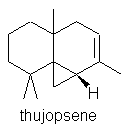
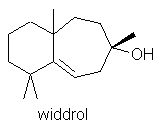
The
oil from C. funebris is pale yellow or yellow-green, with an odour
that is almost invariably smoky,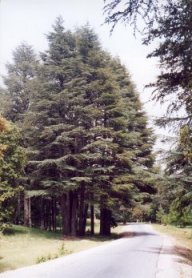 woody, bordering on crude, with an almost
cresylic character. In comparison Cedarwood oil Virginian appears smooth woody, slightly oily pencil
sharpenings, and somewhat slightly sweet in comparison. The Chinese oil is,
however, more powerful.
woody, bordering on crude, with an almost
cresylic character. In comparison Cedarwood oil Virginian appears smooth woody, slightly oily pencil
sharpenings, and somewhat slightly sweet in comparison. The Chinese oil is,
however, more powerful.
(b) Cedarwood oil Texas Juniperus
ashei Buchholz
Texas/Mexican
cedarwood oil essential oil is produced by steam distillation of the wood or
wood shavings of this small tree, which grows in Texas, Mexico and parts of
Central America. Cedarwood oil Texas was sold for under $4 per kilo in the
nineties – it has always been cheap so there was little profit in harvesting
Cedarwood trees, and millions of acres of farmland became invaded by this
opportunist species. The US government offered incentives to clear this land, so
that wood to produce the oil is in adequate supply. Now new technology (in the
form of continual distillation termed “steam stripping” used by Texarome
Inc. of Texas) replaces the older steam distillation process, which used to take
up the 8 hours to remove the essential oil. G. R. Boucard and R.W. Serth
“Practical Design of a continuous distillation plant for the separation of
aromatic raw materials” can be viewed on http://207.71.36.16/distil.htm.
The
odour profile of the oil is of
intense pencil sharpenings, smoky, woody notes with aspects of guaiacwood, but
much drier than other Cedarwood oils. Dry-down is woody, smoky, and dry.
Cedarwood oil Texas contains a-cedrene,
b-cedrene,
thujopsene, widdrol, pseudo-cedrol, b-chamigrene,
cedrol, widdrene, isowiddrene, a-chamigrene
and three cuparene isomers.
©
Phoenician Juniper
Juniperus
phoenicea. L.
Distilled
from wood of shrub, or small conical tree
distributed throughout Mediterranean, and N. Africa and Canary Islands and which
grows to 17m. Entire forests of J.
phoenicea, growing to 2000 m. can be found in Algeria. In Morocco J.
phoenicea f. megalocarpa Maire
in also found on the E. coastal parts of Morocco. J.
phoenicea var. turbinata Parlatore
with egg-shaped seeds has also been described as growing in Algeria, Spain,
Italy and Sicily.
The
odour
of the Lebanese oil is
pine-like with
some turpentine elements, almost cineolic; very toppy; oily; underneath some
leathery warm labdanum character. Dry-down
is powerful amber, labdanum-like, resinous. It has been noted by the author
the intensity of the amber note appears to be seasonally related.
B.M.
Lawrence (1987) reports on the terpene hydrocarbon composition of J.
phoenicea giving the main component as a-pinene
as 70.4% followed by limonene and b-phellandrene
at 8.3%. R.P.Adams et al (1991) compared the leaf oils of J.
phoenicea, J phoenicea subsp. eu-meditrerranea
and J. phoenicea var. turbinata (Guss.) Parl. They discovered that all oils were a-pinene
dominant but J. phoenicea contained moderate amounts of myrcene, limonene, b-phellandrene,
a-terpinyl
acetate and 1-epi-cubenol. The authors experience is that a-pinene
and d-3-carene
constitute >85% of traded oils seen, with smaller additional amounts of
myrcene, terpinolene and a-terpinyl
acetate also present.
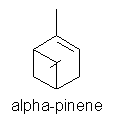
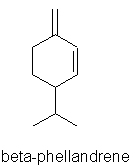
(d)
Drooping Juniper Juniperus
recurva Buch-ham
ex D. Don.
A small tree or shrub of
conical habit, with stringy shaggy bark and drooping branches. The species is of
interest as the wood and sawdust, especially that from J. recurva var coxii
and J. recurva var. squatama Parl. (Weeping Blue Juniper) is burnt
as incense, and set out in open vessels scenting the air with a cedarwood-like
fragrance in Buddhist temples in the E. Himalaya. The photographs illustrate
scenes where the author has experienced these wonderful scented odours.
(e)
Cedarwood
oil Virginian
Juniperus
virginiana
L.
Virginian
cedarwood oil is the volatile essential oil produced by the steam distillation
of the chopped wood, stumps, logs, wood shavings or sawdust of the slow-growing
Eastern Red Cedar, growing in the S.E. of USA, Canada and Japan. The oil
is yellow to yellow-brown (sometimes red-brown), often solid or semi-solid at
room temperature due to precipitated cedrol. Redistilled oils, where sold, are
almost colourless. The oil has a woody, oily, somewhat dry odour
but cleaner, and markedly smoother than Atlas or Himalayan oils although less
powerful. There is a distinct pencil-sharpenings note. Dry-down is still smooth woody-oily, retaining the pencil-sharpenings
aspect.
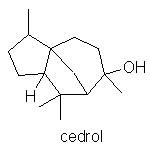
Virginia
cedarwood is considered by many perfumers to have a smoother and finer (but less
powerful) odour than Texas oil. The major odour impact compound of cedarwood
oils is considered to be (+)-a-cedrol,
which occurs at up to 15% in the oil; the major portion of the oil being
composed a-
and b-cedrenes
and thujopsene which are weak woody odourants. The sesquiterpene hydrocarbon
content is between 55-65%. Cedarwood
oil Virginia shows a higher cedrol content than the Texas oil, and higher b-caryophyllene
and g-eudesmol,
whereas Chinese oils show higher thujopsene contents.
Cedarwood oil Virginia is additionally used in insecticides, polishes and
cleaning products, soaps, linaments, and cedarwood still residues have been used
in the manufacture of linoleum.
Other
Minor Cedarwood Oils.
Many
of these exist, including:
Chamaecyparis
lawsoniana (A.
Murr.) Parl.– Port Oxford Cedarwood
(contains up to 46% a-
& b-
pinene).
Chaemaecyparis
nootkatensis (D.
Don) Spach – Yellow cedar – wood used as incense.
Chamaecyparis
obtusa (Siebold
& Zucc.) Endl. – Japanese Cedarwood “Hinoki” – the oil has a limited
use in perfumery. Japanese government have protected trees of this species since
1982.
Juniperus
procera Hochst
ex Lindl.- East African Cedarwood (oil not now commercially traded). Included
in FAO listing of endangered tree and shrub species and provenances (FAO 1986).
Accelerated mortality studies in Kenyan forests conducted by Anderson et al.
(1994) and Ciesla et al. (1994). The oil contained mainly a-cedrene
and a-cedrol
(the latter to 40%).
Thuja
occidentalis L.-
White Cedar tree giving “cedarleaf” oil, which contain up to 65% of thujones.
Thuja absolute and concrete, produced by solvent extraction of the fresh leaves
and twigs are used in perfumery for fresh herbal notes, and in masculine
fragrances etc.
Thuja
plicata – Don
ex D. Don - Western red cedar. Leaf and heartwood oils contain anti-insecticidal
troplones, leaf oil additionally contains methyl thujate, T-muurolol as major
components; this is sometimes sold as “cedarleaf oil” also.
Thuja
dolabrata
(L.f.) Siebold & Zucc.- Hiba wood, (Japanese Cedarwood) oil used in
perfumery. The wood of this evergreen conifer contains up to 75% thujopsene,
also b-thujaplicine
and (notably) carvacrol, the latter being a chewing rodent deterrent!
Widdringtonia
whytei Rendle
Mlanje Cedarwood Oil. Some limited local use in parts of Africa.
§7.
ANALYTICAL COMMENTS.
Although
there are some similarities in the major chemical constituents (sesquiterpene
hydrocarbons etc.) of Cedrus atlantica and Cedrus deodara (see
Part 1 of this article), there is little similarity between the
latter oils and the constituents of the more commonly traded oils of Cupressus
funebris, Juniperus ashei or
Juniperus
virginiana, nor
yet between those “Cedarwood” oils having a predominance of monoterpene
hydrocarbons, such as oil from Chamaecyparis
lawsoniana.
§8.
SAFETY ISSUES WITH CEDARWOOD OILS.
Cedarwood oil Atlas when tested at low doses was found to be
relatively non-toxic, non-irritating, non-photo-toxic & non-sensitizing –
see Opdyke (1976a). Some aromatherapy authors indicate that Cedarwood oil Atlas
should be “best avoided in pregnancy” (e.g. Lawless, 1995), although the
scientific basis for this is not clear. The oil is classified with a R65
hazard phrase (: may
cause lung damage if swallowed) since
the hydrocarbon content may be present at up to 60% - well over the 15% point of
labelling requirement. The safety phrase S62 is also recommended (if
swallowed do not induce vomiting: seek medical advice and show this container or
label). In the case of an accident, be ready to quote the CAS number: 8023-85-6.
Cedarwood oil Himalayan has had no formal RIFM testing, but
has been found to possess some toxic effects:
see ACIP (1980). Lack of safety
testing may reflect its relatively late introduction (late 1950’s) into
essential oil trading circles, originally largely confined to India’s internal
markets.
Cedarwood
oil Texas when
tested at low doses is relatively non-toxic, non-irritating, non-photo-toxic
& non-sensitizing – see Opdyke (1976b) [N.B. although
early work e.g. Greenbaum S. (1934). etc. indicated subsequent
photo-sensitisation problems to certain individuals exposed to toiletries
containing cedarwood oil, this was not verified by Urbach & Forbes (1973)].
Furthermore, allergy was not recorded in any of 95 volunteers treated with
cedarwood oil at 1% and 5% conc. in petrolatum as found by Frosch P.J. et al.
(1995).
The oil is
classified with a R65 hazard phrase since the hydrocarbon content may be present
up to 60%, and S62 safety phrase labeling is also recommended. The CAS No is
68990-83-0.
Cedarwood
Oil Virginian. Considering
the relatively clean bill of health given to Cedarwood oil Texas, and the broad
similarities between the compositions of the two oils, a slightly different
picture emerges for Cedarwood oil Virginian.
Cedarwood oil Virginia when tested at low doses was found to be relatively
non-toxic, non-irritating to human skin, non-phototoxic & non-sensitizing (Opdyke
1974). As
regards phototoxicity, although Urbach & Forbes (1973) found no phototoxic
effects, there are several reports of toilet preparations containing Cedarwood
oil Virginia causing dermatitis /pigmented dermatitis. Again, the oil is
similarly classified with a R65 hazard phrase since the hydrocarbon content may
be present up to 60%, but suggested advice is that it is also labelled as Xn
Harmful, as well as the S62 safety phrasing. The CAS No is 8000-27-9.
The
oil is commonly indicated as abortifacient in popular high-street Aromatherapy
books e.g. Lawless (1995) p. 160, or as possible abortifacient Miller &
Miller (1995), although the basis for this is not clear. Lawless does not,
however, similarly remark that Texas Cedarwood oil from J.
ashei is an abortifacient in spite of shared compositional features
(although to be fair, it is stated best avoided during pregnancy). Miller &
Miller (1995) also repeat the semi-popular belief that (Virginian) Cedarwood oil
will help provoke an overdue menstrual cycle (Lawless just cites emmenagoguic
effects). Again the basis for this is clinically unclear, although since Miller
& Miller also apparently believe that Cedarwood Virginiana contains thujone,
the whole situation may easily arise from confusion with other oils.
Cedarwood oil Virginia
has been previously found to have tumour producing properties on mouse-skin (Roe
& Field 1976) – however the oil was applied in benzene! (a known
carcinogen!). Slightly more worrying perhaps is the finding that bedding
materials of cedarwood shavings increased the incidence of spontaneous tumours
of the liver and mammary gland susceptible strains of mice (Sabine 1975).
References:
Adams
R.P. (1991) “Cedar Wood Oil – Analysis and Properties” in Modern
Methods of Plant Analysis New Series Vol 12 Essential Oils and Waxes ed. H.F. Linskens and J.F. Jackson pub. Springer-Verlag
N.Y. p159-173
Anderson
R.L., Theuri D.K., Kanyi B., Ojwang J., Ndauti G & Ward J.G.D (1994)
“Assessment of Forest Diseases in Kenya with specific emphasis on cedar
decline” - carried out for FAO of the United Nations, Rome, Italy.
A.C.I.P.
(1980) Annual Conf Indian
Pharmacol Soc (1980)
abstr. 15.
Burfield
T. (2000) Natural Aromatic Materials – Odours and Origins pub. Atlantic
Institute of Aromatherapy, Tampa 2000.
Burfield T. (2002) "Odour Profiling (of Essential Oils) and
Subjectivity" - talk given at the RQA's 12th Annual Conference Saturday,
9th March 2002 Regent's College Conference Centre, London.
Ciesla
W.N., Mbugua DK & Ward JGD (1994) “Preliminary observations on dieback of
Juniperus procera in Kenya” Integrated Forest Pest Management Centre, Ministry
of Environment and Natural Resources and FAO of the United Nations FO:
DP/KEN/91/005, Field document 6.
FAO
(1986) Databook
on Endangered Tree and Shrub Species and Provenances
Forest
Resources Division, Forestry Department, Forestry Paper 77.
Greenbaum
S. (1934) Penn.
Med. J. 38, 28
Frosch
P.J. (1995) “Patch testing with fragrances: result of a multicenter study of
the European Environmental and Contact Dermatitis Research Group with 48
frequently used components of perfumes. “Contact
Dermatitis 33, 333-342.
Lawless
J. (1995) The Illustrated Encyclopedia of Essential Oils pub. Element
Saftesbury, Dorset.
Lawrence
B.M. (1988) Perf
& Flav Dec
1987/Jan 1988 p60.
Miller L. & Miller B.
Ayuurveda Aromatherapy Lotus Press
1995 p235.
Opdydyke D.L.J. (1974) FCT 12, 845-6.
Opdyke D.L.J. (1976a) FCT
14, 709.
Opdyke D.L.J. (1976b) FCT
14, 711.
Roe
FJC and Field W.E (1965) “Chronic toxicity of essential oils and certain other
products of natural origin” FCT 3,
311.
Sabine
JR (1975) “Exposure to an environment containing the aromatic red cedar, Juniperus virginiana: procarcinogenic, enzyme-inducing and
insecticidal effects”. Toxicology 5(2)
221-35.
Urbach
& Forbes (1973) Report to RIFM (1973).
Zhaobang
S. (1995) C.I.F.O.R. Occasional paper No 6 “Production and Standards for
Chemical Non-Wood Forest Products in China” CFIOR Sindangbarang, Bogor,
Indonesia.
Cedarwood
Oils – part 3: Therapeutic Properties.
Copyright Tony Burfield © May 2003.
[This
article first appeared in Aromatherapy Times, Vol 1 No.57 pp 16-18 Summer
2003, and is reproduced by kind permission of the editor].
References to
beneficial effects of cedarwood (wood, leaf, bark) go back to the ancient Greeks
– Dioscorides mentions ‘cedar’ oil used to preserve dead bodies. The Bible
has several references to Cedarwood, but it is not always clear if either of
these sources refer to Cedar of Lebanon Cedrus libani or to Juniper
species such as Juniperus phoenicia. Cedrus libani is official in the PDR
(2000), but, under ‘uses’, the oil is only listed in the monograph as an
expectorant, with application in catarrhal conditions of the upper respiratory
tract only being indicated as unproven. Digrak et al. (1999) further
showed that chloroform, acetone and methanol extracts of the leaves, resins,
cones and fruit of C. libani inhibited development of nine out of ten
bacteria (but not E. coli) although the role of the essential oil content
for these findings is not clear.
In more detail,
therapeutic data is discussed below, but frustratingly, several published papers
describing experimental work using cedarwood oils, do not indicate a botanical
origin, let alone a chemical analysis, rendering the results difficult to
ascribe to any known physiologically active principles. In particular some
critical comments are included below where an apparent lack of scientific rigor
seems to occur in certain published papers.
1. Himalayan
Cedarwood Cedrus deodara
General
properties.
This oil is familiar to aromatherapy practitioners, although its uses stretch
way back in Ayurvedic medicine. Jala (1994) sums up the uses of the oil
in India as being antiseptic, diaphoretic, depurative and diuretic, also being
useful in leprosy, syphilis, skin diseases, wounds and ulcers, fever and
strangury. Since usage of oil and other parts are often confused, for
completeness, it should be mentioned that the bark of the tree is often used as
an astringent & febrifuge, also being employed in fever, and in cases of
dysentery, & diarrhea, & urinary diseases at a dose of 0.7 to 2.8g/day (Chatterjee
& Pakrashi 2001). [The same authors quote the oil as being emetic at a
dose of 1.8g., used in folk medicine for ulcers, rheumatism, flatulence &
leprosy]. Bark extracts have been the subject of a Canadian patent (1967) to
reduce urine and blood sugar levels in diabetics. The wood is considered
diuretic, diaphoretic and carminative (Marg 1992). Ground
wood paste and water are used to dispel headache by applying to forehead and
temples (Maheshwari & Biswas 1970). Free
radical scavenging activity has been ascribed to specific compounds in
chloroform extracts of dried & defatted heartwood powder (Tiwari et al.
2001). Franchomme & Peneol
(1990) ascribe cicatrisante (promoting scar tissue formation), arterially
regenerative, lymphytonic and lipolytic actions to the steam distilled oil,
indicating its use in conditions of antherosclerosis, and in hydrolipid
retention, and for cellulite.
Vetinary Uses
In Indian rural
vetinary practice, both the steam distilled wood oil and oleoresin have a
history of use for ulcerous skin conditions, and a dry distilled oil prepared by
destructive distillation has been used to treat mange in cattle, a 20% dilution
in castor oil being used for buffaloes and calves (Indian
J. Vet Sci (1968) 38, 203; ibid (1976) 53,543). Mixed with
ghee, and sometimes also together with oil of Pinus roxburhii, it has
anti-helmintic (worm killing; dispelling) properties when taken internally.
“Pestoban” is a registered commercial product which is a mixture of three
plant extracts, two of which are known molluscocides: C. deodara, and Azadirachta
indica (Neem) and the potentiator Embelia ribes, which has no
molluscocidal effect itself but which makes the action of the latter two
products 100 times more active (Prosea 1999).
Vascular
permeability
[Agents
that increase vascular permeability increase the local blood supply,
thereby better enabling potential healing mechanisms]. Chandra (1978)
looked at the capillary permeability of C.
deodara wood oil, following up from
the work of Jawahar Lal et al. (1976) who had reported that the oil was more
efficaceous than benzyl benzoate or tetraethylthiuram monosulphide against
sarcoptic mange in sheep. Using a dye as indicator (Evans Blue), Chandra
injected the flanks of 15 shaved adult rabbits (20mg/Kg) and varying
concentrations of C. deodora wood oil
in castor oil were injected intradermally using turpentine oil as a control.
Histamine dihydrochloride was injected at specific spots as a positive control.
The increase in permeability of the dye was recorded at 10, 15, 20 and 30 mins
and at 1,2 and 3hrs after injection. Four rabbits additionally were treated with
mepyramine maleate (25mg/Kg). Finally, in a different experiment, the
subcutaneous tissues of rats were exposed to the oil for 45 mins and stained
with toluidine blue, to examine the effects on mast cells. Chandra et al. found
that C. deodora oil produces a
dose-dependent increase in cutaneous permeability, which was not blocked by
mepyramine maleate pre-treatment. Turpentine and histamine also produced
increases; the effect of a 15% oil solution, was comparable to 1ug histamine
dihydrochloride. The authors
speculate that the beneficial effect of C.
deodara oil in mange-infected sheep may be lie in an increase in vascular permeability to the site of application.
Some
twenty years later, Sharma et al. (1997) looked at the serious skin
problem sarcoptic mange in sheep using Cedrus
deodara and benzyl benzoate (both described as a common acaricidal drugs
in India). Twenty-four lambs divided into three groups (one as control) infected
with Sarcoptes mites were separately
treated on alternative days with the appropriate drugs and the animals monitored
for appearance of lesions, total erythrocytes leukocytes and hemoglobin
concentration every 10 days after treatment. It was found that the group treated
with deodara oil responded faster to
treatment, being free from mites on the 10th day as opposed to
the 14th day. Further, animals treated with deodara had significantly
higher erythrocyte and leukocyte counts compared with the control – the
authors concluded that C. deodara was therefore found more effective than
benzyl benzoate in controlling mange in sheep.
Spasmolytic
activity
[Spasmolytics
help reduce muscle spasm or tension in specific areas - visceral smooth muscle,
gut wall, colon, bronchia etc.]. Work into the investigation of the properties
of sesquiterpene alcohols in C. deodora
was carried out by Dhar
et al.
(1968) who found spasmolytic activity in the 50% ethanolic extract of the wood
of C. deodora .
Himachalol,
a sesquiterpene alcohol from the wood of C.
deodara was isolated by Kar
et al.
(1975) and was found to produce spasmolytic actions, rather similar to
papaverine on various isolated smooth muscles, with other actions including
hypotensive effects, and increasing femoral blood flow. The authors described
himachalol as the major antispasmodic component of the wood. Following this, Panaik
et al.
(1977) evaluated the spasmolytic activity of five sesquiterpene fractions from C.
deodora essential oil: himachalol, allohimachalol, himadarol, centdarol, and
isocentdarol using papaverine as a standard. Himachalol and allohimachalol were
found to be most effective (1.4 to 5 times more active than papaverine).
Using a variety of culture techniques, himachalol has also been shown to
afford some protection against invasive Aspergilli in laboratory mice, and the
authors drew attention to the fact that Aspergillosis infections are
increasingly important in immuno-compromised patients (Chowdhry et al. 1997).
Anti-mosquito
activity
Further to reports that
the oil can be used as an insect repellent (Khadi Gramodyog 1972-3),
Singh et al. 1984 demonstrated a 50% knock down of mosquitoes Anaphales
stephani could be achieved at a 0.45% concentration.
Anti-inflammatory
and analgesic activity
Schinde
et al.
(1999) looked at the possible mechanisms involved in anti-inflammatory activity
of C. deodara oil via the effects on isolated rat peritoneal cells and
inhibition of enzyme lipoxygensaes at a concentration of 200ug/ml. and ascribed
the anti-inflammatory properties of the oil to mast-cell stabilizing properties
and inhibition of leukotriene synthesis.
In
a separate study Schinde et al. (1999a) looked at the anti-inflammatory
and analgesic activity of orally administered steam distilled C.
deodara wood oil by finding an inhibitory effect on the induction of rat-paw
edema, both in exudative-proliferative and chronic phases of inflammation in
adjuvant arthritic rats, at doses of 50 & 100mg/Kg body weight. Hot plate
and acetic acid induced writhing (the latter technique being useful for
examination of peripheral analgesic effects) were both reduced in mice by the
analgesic effect of the oil.
Sleep
Sano et al. (1998) report of the influence of cedar essence (no
botanical origin stated) in decreasing the spontaneous activity and amount of
wake of rats, whilst increasing non-rapid-eye movement (NREM) sleep. In humans
cedar essence exposure reduced NREM sleep stage 2 latency.
2. Cedarwood atlas Cedrus
atlantica.
General
properties
Sheppard-Hanger (1995)
summarised the literature ascribing antiseptic
(urinary, pulmonary), antiseborrheic, aphrodisiac, astringent, emollient,
expectorant, fungicidal, insecticidal, &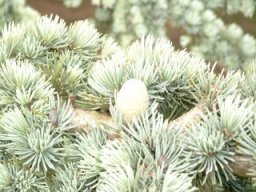 sedative properties to cedarwood
Himalayan oil. Franchomme
& Peneol
(1990) ascribe similar properties to the oil of Cedrus atlantica as they
did to Cedrus deodara: cicatrisante, arterially regenerative, lymphytonic
and lipolytic actions to the oil, indicating its use in antherosclerosis and for
hydrolipid retention and cellulite. Additionally
they indicate potential uses in the case of bronchitis, tubeculosis, dermatoses
and gonorrhea. Other advocates of the “structure-action” theory of
aromatherapy such as Caddy (1997) draw on the fact that (sesquiterpene)
alcohols atlantol and cedrol constitute some 29% of the oil composition,
seemingly in broad agreement accordance with Frachomme & Penoel’s figure
of 30%. It is not my experience that this level of sesquiterpene alcohols is
typical of now-traded Cedarwood Atlas oil, nor do other published analyses
support this (e.g. Chalhat et al. 1994). Adulteration of the oil with cheap
cedarwood oil /cedarwood chemicals
(known in the oil trade to occur to the imported Moroccan oil by certain
unscrupulous French aroma companies who then distribute it to dealers) might
possibly help to explain this discrepancy, or Arctander’s original comments
about artifacts being produced in the oil by high pressure steam or wood pulping
processes may also apply (Arctander 1960).
sedative properties to cedarwood
Himalayan oil. Franchomme
& Peneol
(1990) ascribe similar properties to the oil of Cedrus atlantica as they
did to Cedrus deodara: cicatrisante, arterially regenerative, lymphytonic
and lipolytic actions to the oil, indicating its use in antherosclerosis and for
hydrolipid retention and cellulite. Additionally
they indicate potential uses in the case of bronchitis, tubeculosis, dermatoses
and gonorrhea. Other advocates of the “structure-action” theory of
aromatherapy such as Caddy (1997) draw on the fact that (sesquiterpene)
alcohols atlantol and cedrol constitute some 29% of the oil composition,
seemingly in broad agreement accordance with Frachomme & Penoel’s figure
of 30%. It is not my experience that this level of sesquiterpene alcohols is
typical of now-traded Cedarwood Atlas oil, nor do other published analyses
support this (e.g. Chalhat et al. 1994). Adulteration of the oil with cheap
cedarwood oil /cedarwood chemicals
(known in the oil trade to occur to the imported Moroccan oil by certain
unscrupulous French aroma companies who then distribute it to dealers) might
possibly help to explain this discrepancy, or Arctander’s original comments
about artifacts being produced in the oil by high pressure steam or wood pulping
processes may also apply (Arctander 1960).
Conway
(2001) discusses the fact that some workers consider the oil
as a subspecies of Cedrus libani (cedar of Lebanon) – and describes
actions as antiseptic, anti-catarrhal, circulatory stimulant, & expectorant
(Conway 2001). A monograph by Hmamouchi
M. (2001) indicates that in Morocco, the leaves and wood of the tree are
used as an anti-inflammatory for rheumatism – disappointingly no other local
ethnic uses as described.
Antiseptic properties.
Gattefosse was able to
draw on many sources for his aromatherapy studies, reporting that Professor
Trabaut pioneered the use of Atlas cedarwood oil at Mustapha hospital in Algiers
in 1899 for venerology. Doses reportedly ranged from 1.6 to 8g. per day,
although higher doses were used initially giving way to lower doses. Further
reports of work by Drs. Evrard, Tant Duffaut and Prof Jausion at Val de Grace
Hospital. Cedar essence was said to be “effective against “rheumatic pains,
atonic wounds, and all manner of other diseases” which are written up in a
volume by Massy (1928)”.
Lis-Balchin
et al
(1998) investigated
the relationship between essential oil composition and biological activity,
testing in vitro for example some 105
commercial essential oils against 25 Gram-positive and Gram-negative bacteria,
and 20 strains of Listeria monocytogenes.
Four cedarwood oils (Atlas,
Chinese, Texas, Virginia) tested were only found to be active against from 2-4
different strains of bacteria and none of the twenty strains of Listeria monocytogenes. On
the basis of these in vitro results
the authors challenged Tisserands report of a good “antiseptic” claim for
cedarwood in his book “The art of
Aromatherapy” revised edn. The authors also state that the composition of
the four cedarwood oils (not shown in the paper) was quite similar and that high
cedrene and thujopsene contents, together with a high cedrol content was not
conducive to high biological action. Tony
Burfield’s comments: This shows the dangers of assuming that
commercial oils are genuine – authentic Cedarwood Atlas oil is generally
assumed to be principally composed of 70% himachalenes and accompanying
atlantones (see Chalchat et al. 1994); similarly Cedarwood Deodar oil has no
major cedrene, thujopsene and cedrol content. These conclusions must therefore
be unreliable as the oils used were ‘untypical’, and Tisserand’s original
comments stand unchallenged by this work, certainly for the time being. In
contrast, other studies (Parfum Kosmet 1980, 61, 219) have
indicated good in vitro efficiency against nine out of ten pathogenic Gm
+ive and Gm –ive bacterial organisms tested, and other work points to
fungotoxic effects (Indian Perfumer 1981, 25(3&4),1).
Hair
growth
Hay et al. (1998) used 86
patients with alopecia areata separated
into two groups in a randomized double blind controlled trial which extended
over 7 months, and massaged essential oils in carrier oils into the scalp on a
daily basis. The authors used oils of thyme, rosemary, lavender, and cedarwood
atlas. Significant improvement was proven by photographic assessment at 3- and
7- month intervals.
3. Cedarwood
Virginia Cedrus
virginiana.
General properties Sheppard-Hanger
(1995) sums up the aromatherapy literature describing the oil as antiseborrhic,
pulmonary & genito-urinary antiseptic and analgesic (similar to sandalwood), antispasmodic, astringent, decongestant,
diuretic, emmenagogue, emollient, fungicide, insecticide, nervous sedative. Franchomme
& Penoel (1990) ascribe venous decongestive effects and phelebotonic
effects to the oil, being indicated for varices, internal & external
haemorrhoids. “Structure-action” theory advocates such as Caddy
(1997) mainly have sesquiterpenes and alcohols to consider from the oil
composition. The author adds little to Sheppard-Hanger’s original summary
except for alleged balancing and diuretic properties.
Leaf decoctions/extracts
According to Hartwell
(1970), decoctions of the
powdered leaves are used to treat skin rashes, veneral warts, bronchitis, rheumatism
etc. Duke and Wain (1981) report that “cedarwood is abortifacient,
diaphoretic, diuretic, emmenagogue, stimulant, sudorific, and taenifuge, red
cedar is a folk remedy for arthritis, bronchitis, catarrh, debility, dropsy,
rashes, rheumatism, skin ailments, venereal diseases, and warts. Leaves used as
a stimulant, emmenagogue, and taenifuge.” They further report that in
Appalachia, a mixture of nuts, leaves, and twigs is boiled and the aromatics
inhaled as a bronchitis treatment.
Clark
et al. (1977) examined the methanolic and hexane extracts
of the bark/sapwood and leaves of 12
US Juniperus spp. and the extracts
which contained essential oil were noted to have a similar activity to
streptomycin against a number of bacteria and fungi.
Insecticidal
properties:
Carter
(1976) looked the inability of the termite (Reticulitermes
flavipes) to survive on the sawdust of J.
virginiana, or of a pentane extract
(which contains essential oil) of the same sawdust. Adams et al. (1988)
broadly confirmed the findings of Carters earlier work above, demonstrating that
seven of the heartwood extracts of 12 Juniperus
taxa of the US showed very high termicidial activities.
Sabine
(1975) had
earlier shown that oil of cedarwood and isolates cedrene
(isomer not identified) and cedrol interrupted the reproductive cycle of
the Peanut Trash Bug (Elasmolomus sodidus), the Indian Meal Moth (Plodia
interpunctella) and the Forage Mite (Tyrophagus putrescentiae).
Naples
et
al (1992) report that the cercariae of S.
mansoni (human parasite pest) will
survive in fresh water until a suitable host presents itself. Once dermal
penetration of the host is achieved, and following the detection of a
penetration stimulant (usually skin lipids or fatty acids e.g. linolenic acid)
physiological changes are accelerated which affect the lifetime of the organism
in fresh water. These changes include disruption of the cercarial glycocalyx,
which alter processes concerned with osmoregulation. Cedarwood oil
may act by acting as a penetration response agent itself, leaving the organisms
vulnerable to hypo-osmotic conditions, and it may increase the ingress of toxic
substances into the organisms.
Cedrol in particular, a principle component of cedarwood oil, seems to have a
high toxicity to cercariae.
Panella
et al.
(1997) examined a number of acaricides, including those extracted from J.
virginiana, and a number of phytochemicals against the immature ticks Ixodes
scapularis. Extracts of J. virginiana were found most effective
against the larval stage of the ticks (LC=0.001% w/v) out of all substances
tested.
On
the other hand cedarwood oil
(botanic origin not specified) in dilution and at 100%, and in combination with
essential oils of Bourbon geranium, cedarwood, clove, peppermint, and thyme failed to repel mosquitos
Aedes aegypti (L.) and Anopheles
albimanus Wiedemann (Barnard 1999). Cedarwood oil was also
one of six mosquito repellent substances tested by Curtis et al. (1987)
against four Anopheles strains of which An. stephansi was found to
be the most susceptible.
Neurotransmitter regulation
Asakura K et al. (1999)
demonstrated that a-eudesmol,
a minor component of the oil of J. virginiana, selectively inhibited the
pre-synaptic omega-agatoxin IVA (omega-Aga-IVA)-sensitive Ca2+
channel, which according to the authors, has been found to play an important
role in the physiological neurotransmitter release in mammalian nerve terminals.
Other properties
Opdyke (1974) gives several
references to mice exhibiting reduced hypnotic effects [e.g. Wade
et al. (1968)] with hexobarbitone via exposure to fragrant cedarwood bedding
inducing microsomal enzymes which degrade hexobarbitone.
4. Cedarwood Texas Juniperus
mexicana
General Properties:
Sheppard-Hanger (1995) describes the aromatherapy literature as alluding
to antiseptic, antispasmodic, astringent, expectorant, nervous system sedative,
circulatory (venous) & lymphatic decongestant / stimulant proerties. Franchomme
& Peneol (1990) ascribe the same properties for Cedarwood oil Texas as
for cedarwood oil Virginia: venous decongestive effects and phelebotonic
effects, being indicated for varices, & internal & external
haemorrhoids.
Little
published data is specifically available for therapeutic effects this oil that
the was able to unearth. Cedarwood oil (no origin
stated) had a weak therapeutic action against tuberculosis when injected
10mg/week (as 2% solution in olive
oil) into guinea pigs which are receiving sub-effective doses of
dihydrostreptomycin (Kato & Gözy 1958).
5. Other
Cedarwood species.
The
insecticidal activities of J. recurva
heartwood extracts from Nepal, including the steam volatile oil, were examined
by Oda et al. (1977). They examined the individual components of the oil for
activity, and found that the most active components were thujopsene (with an LD50
of 4.5 mg/mosquito)
and 8-cedren-13-ol. Many components e.g. b-cedrene,
cuparene, widdrol and acoradiene were found inactive. There are clear
implications for further research into other ‘cedarwood’ oils here. The wood
leaves and twigs of this fragrant J. recurva is used in incense in
Himalayan districts, the smoke from the green wood being considered emetic (Marg
1992a).
6. Conclusions.
Broadly speaking, the traditional folk-law and more recent aromatherapeutic
properties ascribed to Himalayan and Atlas cedarwood oils, arising from the
combination of sesquiterpene and sesquiterpene derivatives contained therein,
seem to be broadly confirmed by what little recent experimental work was found
by the author in this brief survey. Hard therapeutic evidence for the properties
of Virginian and Texan cedarwood oils, which have a different composition, is
more difficult to find. The latter two oils may substitute in properties for
Himalayan & Virginian cedarwood oils in some application areas, but
certainly not in others (see detail above).
Further, it is likely that many oils on the aromatherapy market are not
genuine, especially since production tonnages of Atlas and Himalayan cedarwoods
are dropping, and relatively cheap Chinese cedarwood oil, known to be frequently
used as an adulterant of these oils, has been easily available and imported into
Europe and the USA in large quantities, in recent times. Although the
composition of Chinese cedarwood Cupressus funebris resembles Virginian
and Texan oils, but is much cruder in odour profile, the composition of Chinese Cedrus
deodar (grown in SW Xizang) is very distinctly different to the Indian oil,
and in no way can be used as an equivalent oil.
References:
Adams RP et al. (1988).
“Termicidal activities in the
heartwood, bark/sapwood and leaves of Juniperus
sp. from the US”
Biochem Syst Ecol 16, 453-456
Arctander S (1960) Perfume and Flavour
Materials of Natural Origin pub. Elizabeth NJ (USA).
Asakura K, Kanemasa T,
Minagawa K, Kagawa K, Ninomiya M (1999) “The nonpeptide alpha-eudesmol from Juniperus
virginiana Linn. (Cupressaceae) inhibits omega-agatoxin IVA-sensitive Ca2+
currents and synaptosomal Ca2+ uptake” Brain Res
823(1-2),169-76.
.
Barnard DR
(1999) “Repellency of essential oils to mosquitos: Diptera:
Culicidae”. J.
Med.
Entomol. 36(5), 625-9.
Bible
references: Leviticus 14:4, 14:6, 14:49, 14:51-54.
Caddy
R (1997) Aromatherapy in Colour Amberwood Publishing GB.
Canadian
patent (1967) 767079.
Carter
FL (1976) “Responses of subterranean termites to wood extractives” Mater
Org. Beih 3, 357-364.
Chalchat J-C, Garry R-P
& Michet A (1994) “Essential oil in sawdust of Cedrus atlantica
from Morocco” JOER 6, 323-325.
Chandra S et al. (1978) Indian
Vet. J. 55, 963-965.
Chatterjee A &
Pakrashi SC Treatise of Indian Medicinal Plants (NISC Delhi 2001) Vol 1,
page 14 et seq..
Chowdhry
L, Khan ZK & Kulshrestha DK (1997) “Comparative in vitro and in vivo
evaluation of himachalol in murine invasive Aspergillosis” Indian
J. Exptl. Biol. 35(7) 727-734.
Clark
AM et al. (1990) “Anti-microbial properties of the heartwood, bark/sap wood
and leaves of Juniperus spp.” Phytother
Res. 4, 15-1977.
Conway
P (2001) Tree Medicine Judy Piatkus (pub) Ltd London p155
Curtis
CF, Lines JD, Callaghan A, Hill N & Karimzad MA (1987) “The relative
efficiency of repellents against mosquito vectors of disease” Med Vet
Entomol 1(2), 109-19.
Dhar
et al. 1968 “Screening of Indian Plants for biological activity: part 1.” Indian
Journal of Experimental Biology 6,
232-239.
Digrak
M, Ilcim A, Hakki AM (1999) “Antimicrobial activities of several parts of Pinus
brutia, Juniperus oxycedrus, Abies cilicia, Cedrus libani
and Pinus nigra.” Phytother Res 13(7), 584-7.
Duke, JA & Wain KK (1981) Medicinal plants
of the world. 3 vols.
Franchomme
P. & Peneol D (1990) l’aromathérapie excactment pub. Jollois.
“Gattefossés Aromatherapy” ed & revised by R.
Tisserand pub CW Daniel 1993. p76
Gramodyog Khadi.
(1972-3), 19, 269.
Hay
I.C., Jamieson M, & Ormerod A.D. (1998) “Randomized trial of aromatherapy.
Successful treatment for alopecia areata.” Arch
Dermatol
134(11),1349-52
Hmamouchi M (2001) “Les
Plantes Médicinales et Aromatiques Marocaines” 2nd edn p. 67
Jahawar
Lal et al. (1976) Indian Vet. J. 53, 43.
Jalal
AV (1994) ed. Indian Medicinal Plants 2 pub Orient Longman p41.
Kar K, Puri VN, Patnaik GK, Sur RN, Dhawan BN,
Kulshrestha DK, Rastogi RP (1975) “Spasmolytic
constituents of Cedrus deodara (Roxb.) Loud: pharmacological evaluation
of himachalol.” J Pharm Sci 64(2), 258-262.
Kato
L. & Gözy B (1958) “Treatment of experimental tuberculosis of guinea pig
with dihydrostreptomycin and simultaeneously with substances acting on the
host.” Archs int. Pharmacodyn.
Therap. 117, 52.
Lis-Balchin et al (1998)
“Relationship between bioactivity and chemical composition of
commercial essential oils” Flav. &
Frag. J. 13,
98-104.
Maheshwari P &
Biswas C (1970) Botanical Monograph
No 5 Cedrus – CSIR New Delhi 1970 p108.
Marg KSK (1992) The
Useful Plants of India NISC CSIR Delhi 1992 p112.
Marg KSK (1992a) ibid
p 305.
Massy
M. (1928) “Le cedre de l’atlas et les products qu’il fournit a la
therapeutique”.
Naples
JM, Shiff C J, RosIer KH (1992)
“Schistosoma mansoni: cercaricidal effects of cedarwood oil and various of
its components” J Trop Med Hygiene 95(6),390-396
Oda
J. et al. (1977) “Studies on insecticidal constitutents of Juniperus
recurva” Buch. Agric. Biol. Chem. 41,
210-204.
Opdyke
DLJ FCT (1974) 12,
845.
Panella NA, Karchesy J, Maupin GO,
Malan JC & Piesman J (1997) “Susceptibility of immature Ixodes
scapularis (Acari:Ixodidae) to plant-derived acaricides.” J
Med Entomol 34(3), 340-5.
Patnaik
GK et al. (1977) “Spasmolytic activity of sesquiterpenes from Cedrus
deodora. Indian Drug Manuf. Assocn.
Bulletin (VII) 18, 238-242.
PDR (2000): PDR for
Herbal Medicines 2nd edn. pub. Medical
Economics Co. Montvale NJ (2000) p 169.
Prosea
(1999) Plant Resources of SE Asia 12 (1) Medicinal and poisonous plants
1, pub. Prosea Foundation, pub. Backhuys Publicns, The Netherlands
p255.
Sabine
JR (1975) “Exposure to an environment containing the aromatic red cedar
Juniperus virginiana: procarcinogenic, enzyme-inducing and insecticidal
effects” Toxicology 5(2), 221-35.
Sharma
DK et al. (1997) Small Ruminant Research
26, 81-85.
Sheppard-Hanger S, (1995)
The Aromatherapy Practitioner Reference
Manual, AIA, Tampa, Fl.
Shinde UA, Kulkarni KR,
Phadke AS, Nair AM, Mungantiwar AA, Dikshit VJ, Saraf MN. (1999) “Mast
cell stabilizing and lipoxygenase inhibitory activity of Cedrus deodara (Roxb.)
Loud. wood oil.” Indian J Exp Biol 37(3), 258-61
Shinde UA, Phadke AS, Nair AM, Mungantiwar AA, Dikshit VJ, Saraf MN
(1999) “Studies on the anti-inflammatory and analgesic activity of Cedrus
deodara (Roxb.) Loud. wood oil.” J Ethnopharmacol 65(1),
21-7.
Singh D, Rao SM & Tripathi AK (1984) “Cedarwood oil as a potent
insecticidal oil as an agent against mosquitoes.” Naturwissenschaften 71(5),
265-6.
Tiwari AK, Srinivas PV, Kumar SP, Rao JM. (2001) “Free
radical scavenging active components from Cedrus deodara “J
Agric Food Chem 49(10), 4642-5.
Wade
et al. (1968) “Alteration of drug metabolism in rats and mice by an
environment of cedarwood” Pharmacology
1, 317
Back To Top
Part 2
Start Part 3 Start
BACK TO MAGAZINE
INDEX
 which can grow to 65m. at an elevation of 1400-2500m. in on several types
of soil in 133,653 hectares of Cedar forest (Mardaga 1999) in the Moroccan
Middle Atlas, Rif central and Grand Atlas Oriental and Middle Atlas oriental. It
has been estimated that Cedar forest might which constitute 2.8% of the total
area of Moroccan forest. The tree also grows in NW Algeria, and has been
imported into N. America & Canada. The tree has been important in the
socio-economy of Morocco, being good for furniture making. Whilst Cedarwood
atlas trees are well conserved in specific area of parkland, the ecosystem is
very fragile - often the margins are subject to degradation by erosion,
demineralisation, dehydration, desertification etc. resulting in areas of
complete desolation. From what I have seen there this year, the Moroccan
ministry of Agriculture and various other bodies are doing all they can in very
difficult circumstances to conserve the rich biodiversity of plants in Morocco.
which can grow to 65m. at an elevation of 1400-2500m. in on several types
of soil in 133,653 hectares of Cedar forest (Mardaga 1999) in the Moroccan
Middle Atlas, Rif central and Grand Atlas Oriental and Middle Atlas oriental. It
has been estimated that Cedar forest might which constitute 2.8% of the total
area of Moroccan forest. The tree also grows in NW Algeria, and has been
imported into N. America & Canada. The tree has been important in the
socio-economy of Morocco, being good for furniture making. Whilst Cedarwood
atlas trees are well conserved in specific area of parkland, the ecosystem is
very fragile - often the margins are subject to degradation by erosion,
demineralisation, dehydration, desertification etc. resulting in areas of
complete desolation. From what I have seen there this year, the Moroccan
ministry of Agriculture and various other bodies are doing all they can in very
difficult circumstances to conserve the rich biodiversity of plants in Morocco.








 woody, bordering on crude, with an almost
cresylic character. In comparison Cedarwood oil Virginian appears smooth woody, slightly oily pencil
sharpenings, and somewhat slightly sweet in comparison. The Chinese oil is,
however, more powerful.
woody, bordering on crude, with an almost
cresylic character. In comparison Cedarwood oil Virginian appears smooth woody, slightly oily pencil
sharpenings, and somewhat slightly sweet in comparison. The Chinese oil is,
however, more powerful.



 sedative properties to cedarwood
Himalayan oil.
sedative properties to cedarwood
Himalayan oil.